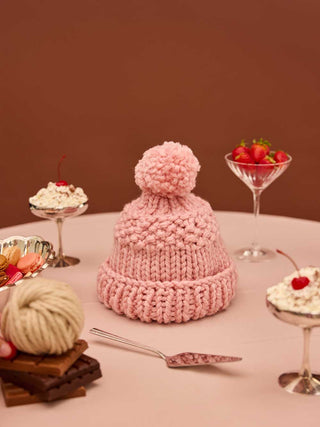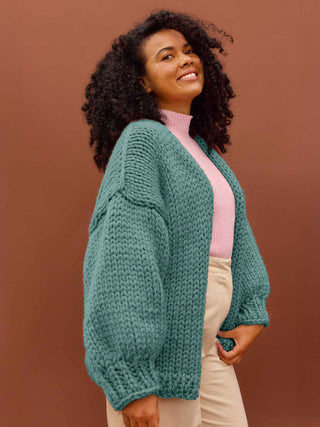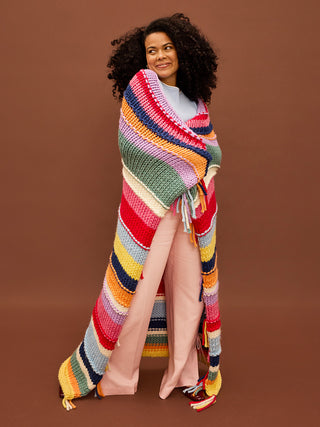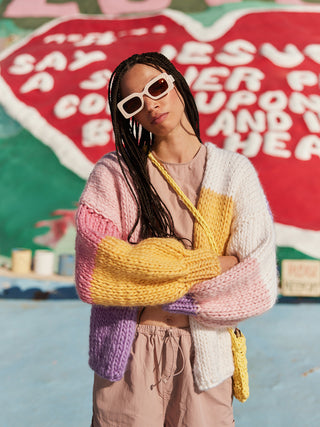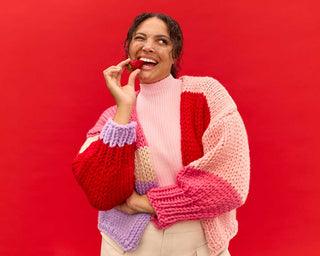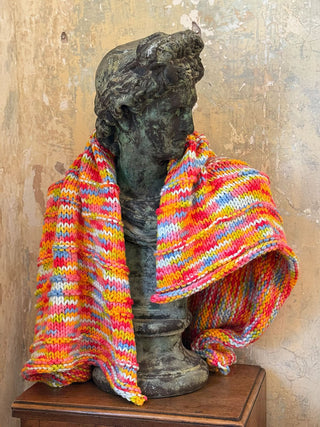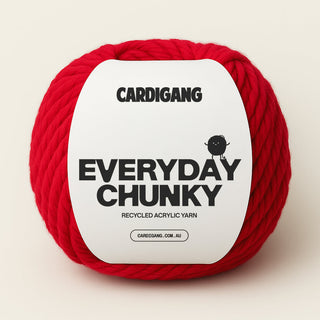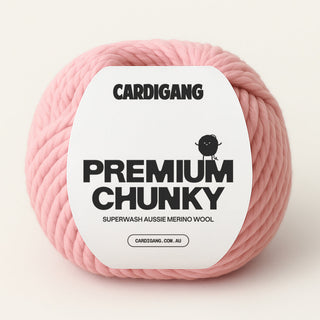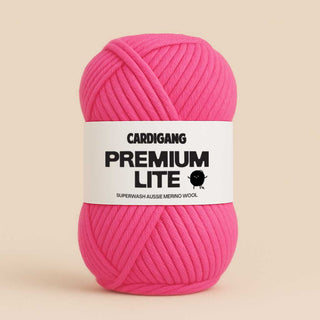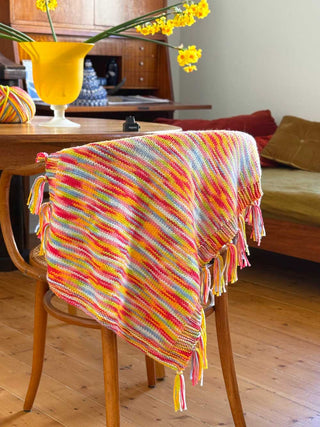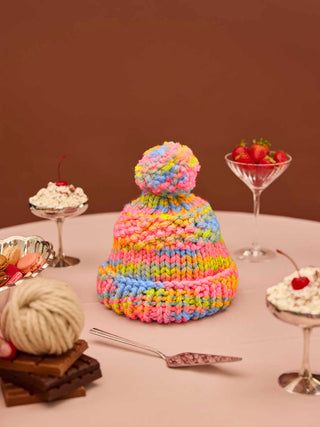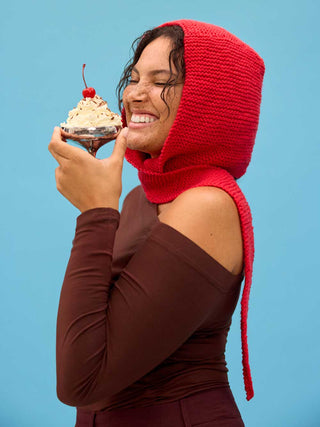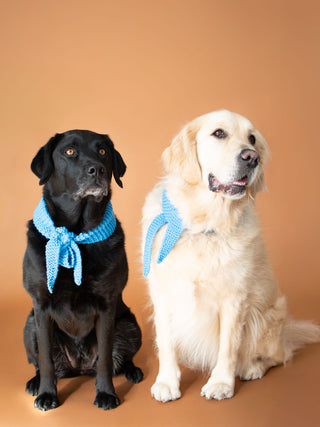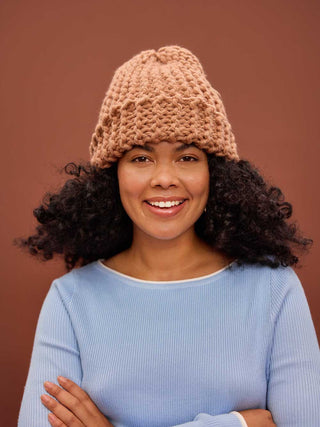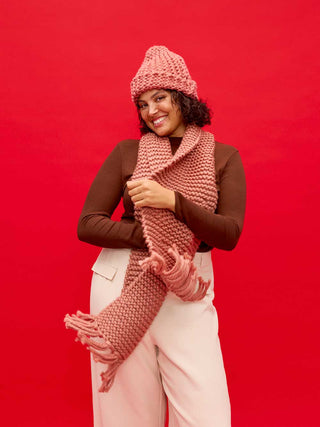A step-by-step guide to knitting the Lily Top.
Ever gotten halfway through a project and thought “Hang on, am I even doing this right?”
We have 🙋♀️
That’s why we’ve created these step-by-step guides to walk you through the knitting process.
THE BASICS
If you're a total knitting newbie - WELCOME! 👋 Learning to knit can feel a bit like learning code. We've stripped away the complicated jargon and tried to keep things really simple so even the newest knitter can master the skill 🧶👩🎓
Before we get started on the pattern we suggest you spend a bit of time learning the basic stitches you’ll need to complete your masterpiece (spoiler - there are only five!). You can use the yarn that came in your kit to practice with. Once you've got these mastered you'll find this pattern is a cinch!
Click here to learn the basics
⚡️Let's get ready to rumble ⚡️
TEST YOUR TENSION
First thing's first. Before you start your project, make sure your tension (how tightly or loosely your knitting is) is juuuust right 🥣 We do this by knitting a “tension swatch”. It's a bit like goldilocks, if the tension is too tight, your piece will be too small, and if it's too loose it may not hold its shape and might be too big.
If done correctly, your 10x10cm knitted swatch should be 11 stitches wide and 16 rows high when knitted in stockinette on 6mm needles.
To test your gauge grab your needles and chunky cotton yarn. Cast on 16-20 stitches, then knit in stockinette stitch (knit first row, purl second repeat) for 18-20 rows. Then measure your 10x10cm swatch and count the stitches and rows within your 10x10 square.



💡 We know knitting a gauge swatch can seem like a bit of a drain, but it's really important because the difference of a few millimetres in a gauge swatch can lead to a finished piece this is quite different in size to what you intended.
Onto the knit
Remember, if you need a refresher on any of the techniques, check out our Learn to Knit page.
SIZING
You can knit your top in size 6-8, 10-12, 14-16, 18-20 or 22-24. Your pattern is read like this: 6-8 (10-12, 14-16, 18-20, 22-24). Make sure you're following the right instructions for your chosen size.
MEASUREMENTS
Laying flat, your finished piece will measure approximately:
- 6-8: 47cm wide x 51cm high
- 10-12: 50cm wide x 53cm high
- 14-16: 53cm wide x 53cm high
- 18-20: 56cm wide x 63cm high
- 22-24: 60cm wide x 63cm high
USING YOUR PATTERN
One of the things we found the hardest when we were learning to knit was keeping track of our rows. Before we were able to easily identify a row of stitches we used a pen and paper to keep track. That's why we've included handy circles in our patterns - you can tick them off as you go. The dashed circles are for the larger sizes.
LET'S KNIT UP A STORM
We knit our masterpiece in the round which means we use our circular needles and knit continuously in loops. When knitting in the round, you’re always knitting on the “front” side of your work so you don’t need to turn the piece to knit on the “back” side. Plus, there’s less sewing together at the end!
BODY
We knit the body from the bottom up in the round. When we reach the point where our arm holes begin, we'll split our work and knit the front and back pieces separately in rows, rather than in the round.
STEP 1
Cast on your stitches. We recommend using the long-tail cast-on method when using the chunky cotton yarn. It's a lot easier to get the new stitches onto your needle.
JOIN YOUR STITCHES
STEP 2
Complete 3 loops of rib stitch. Remember to move your yarn from the front to the back of your work as you alternate knit and purl stitches.
STEP 3
Next, you'll knit in knit stitch for the number of rows/loops instructed. 💭 Remember to use your stitch market to keep track of the number of loops completed.
STEP 4
🧶 Time to change colour for the first time. To change colour you'll tie the new colour yarn to the old colour and start your next loop in the next colour. Make sure you're doing this at the point of the first stitch in your 11th row- the stitch marker will help you identify that stitch.
STEP 5 - 7
Continue in knit stitch, changing colours as instructed.
STEP 8
⚡️ We're going to split our work now and start knitting up the front and back of our top separately. This means we're knitting flat and not in the round so you'll be alternating knit and purl rows.
We're also going to shape the arm holes so you'll be decreasing stitches along your rows.
We start with the stitches for the back part of the top. The stitches for your front will just hang out on your needles and we'll come back to them once the back is done.
📉 You'll knit this row and decrease stitches as instructed at the beginning and the end of the row.
STEP 9
This is a standard purl row.
STEP 10 - 27 (27, 27, 30, 30)
Follow the instructions, completing decreases and changing colour where instructed. Note that sizes 18-20 and 22-24 have some extra rows to complete before you cast off.
Cast off your stitches, cut your yarn and thread the tail back through the last stitch to secure it.
Well done 💪 You've finished the back!
STEP 31
Reattach your yarn to your work by tying a knot to the base of the stitch closest to end of your needle. You want to start on a knit row, so make sure that the side of your work with the little v's is facing you.
STEP 32
Good news, the front is knitted in the same way as the back! You'll be good at this by now. Simply follow the instructions again until you get to row 80 (84, 86, 100, 100).
STEP 33
We're going to do a row of shaping for the neckline. Knit your first 4 stitches, then knit two together. Next, we're going to cast off stitches to create the neck hole. Cast off the required number of stitches, then we'll mirror the stitch decrease on this side of the row.
STEP 34
Purl the stitches for the first shoulder stitches.
STEP 35
Cast off the stitches for the first shoulder. Secure the last stitch by cutting your yarn from the ball and threading it through the last stitch.
STEP 36 - 37
Rejoin your yarn so that you can purl and then cast off the stitches for the second shoulder.
The front is F.I.N.I.S.H.E.D! 🥳 Have a stretch and give yourself a pat on the back.
SEWING IT TOGETHER
Now it’s time to get to work with the darning needle to sew your shoulders together.
STEP 1
Lay the ends of your front and back shoulders on a flat surface with the ends butting up against each other and the right sides facing up.
STEP 2
Sew the pieces together using the invisible seam technique.
Weave in your loose ends using your darning needle.
Time to rock your masterpiece 💪🔥🥳
Well done on finishing your knit! Epic job. We know from experience that there's nothing quite like that first time someone asks you where you got your knit from 😎
We'd LOVE to see how you go! Share your masterpiece with us by tagging @cardigang_knits on socials or by sending us an email at hello@cardigang.com.au
Until next time! 😘🧶💕
Morgan & Cat xx


